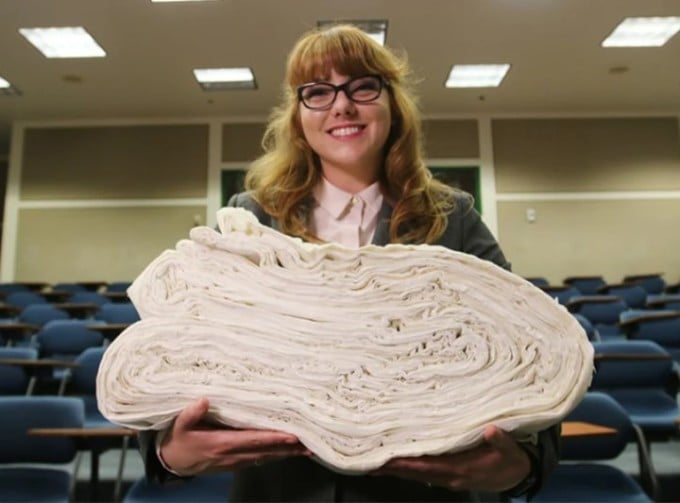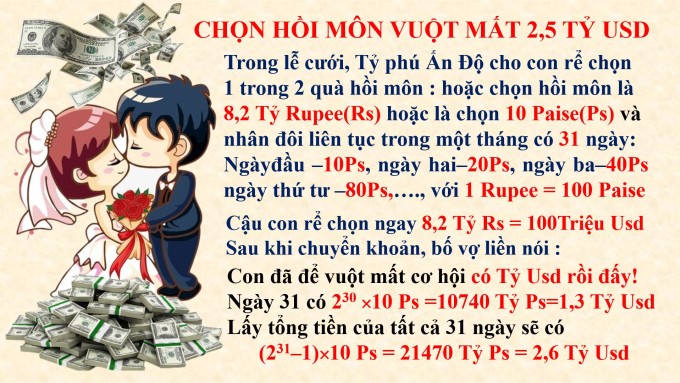The world around us is full of wonders, and sometimes intuition tricks our thinking. Below are four math problems that seem easy to solve in a few minutes, but are not so simple.
1. The problem of arranging rice on a chess board
In the 6th century, the King of India intended to reward Seta - the inventor of chess - with gold and silver, but Seta refused and wanted to be rewarded with rice grains in the following way: "Place 1 rice grain in the first square, 2 grains in the second square, 4 grains in the third square,... and so on, the next square is double the previous square and placed until the end of the 64-square chessboard".
The King accepted and did not forget to mock that Seta had missed the opportunity to get rich.

However, the next day, the King realized his mistake because the number of rice grains was terrifyingly large: 1+ 2+ 2 to the power of 2 + ... 2 to the power of 62 + 2 to the power of 63 = 2 to the power of 64 - 1 = 18,446,744,073,709,551,615
This amount of rice was millions of times larger than the King's current amount of rice and could cover the entire surface of the earth. Knowing that he could not give enough rice as a reward, but to keep his promise, the King listened to the wise man's words and ordered: "Seta, you must count each grain of rice yourself accurately."
According to calculations, it would take 60,000,000,000 years to count all the rice grains and if each granary was 4 m high and 10 m wide, then to contain all the rice grains, the length of these granaries lined up one after another would stretch to 300,000,000 km, which is twice the distance from the Earth to the Sun.
2. Paper folding problem and Guinness World Record 2002
Try folding a thin sheet of A4 paper in half, and you'll see that you can only fold it a maximum of 7 times! After the 8th fold, you'll have to fold a 256-page book in half.
To fold more, in 2002, Britney Gallivan - a high school student in the US, chose 0.1 mm thick tissue paper 1,219 m long and spent 8 hours crawling in a long corridor in a California shopping center to fold the length of the paper strip 12 times in a row. The female student was later recognized by the Guinness World Record for the person who folded a piece of paper the most times.

Britney Gallivan folded a 1,219-meter-long paper tape into 4,096 layers, setting a Guinness record. Photo: Guinnessworldrecords
As we continue to do the calculations, we will see the terrible power of exponentiation even with base 2 - the smallest natural number greater than 1.
With a paper thickness of 0.1 mm, after the nth fold the paper thickness will be 2 to the nth power x 0.1 mm. More specifically, at the 12th fold the paper is as thick as a chair, but at the 17th fold it is as thick as a 2-story building.
After 42 folds, the paper will be 439,800 km thick - that is, longer than the distance from Earth to the Moon (384,400 km). Each time the paper is folded, its thickness will double and its surface will be halved. When folded 51 times, the paper shuttle will be longer than the distance from Earth to the Sun, 200 million km. And after 103 folds, the super-small paper fiber will be longer than 100 billion light years, that is, longer than the diameter of the observable universe, which covers about 93 billion light years (light speed 300,000 km/s).
3. The problem of son-in-law choosing dowry in 2017
In 2017, India hosted the 19th International Junior Mathematics Olympiad (InIMC). Knowing that Indian marriage ceremonies are very different from other countries, I created a fun math problem for the Vietnamese 6th grade team during the training for the InIMC 2007 competition.
This problem retains the original idea of doubling but is modified to fit the traditional Indian marriage where "the son-in-law receives a dowry from the bride's family".

4. The problem of the number of people infected with SARS-CoV-2 virus
In March 2020, during the Covid-19 pandemic, I composed a poem by Dr. Nguyen Manh Thang into a song: "The world together fights the Corona Virus pandemic" and a problem about the growth rate of the SARS-CoV-2 virus in the human body.
The question is as follows: A person has just been infected with the SARS-CoV-2 virus and every 3 minutes each virus duplicates itself into 2 new viruses. Suppose after 81 minutes of infection, the human body has 402,653,184 viruses and the disease begins, then how many SARS-CoV-2 viruses were initially infected in the human body?
Solution: This is a problem with the opposite structure of the previous 3 problems. To solve it, we will analyze 81: 3 = 27 and 402,653,184 = 3×2 to the power of 27.
From there, the answer is that the human body is initially infected with 3 SARS-CoV-2 viruses.
Tran Phuong (Deputy Director of Talent Development Center)
Source link






























































































Comment (0)